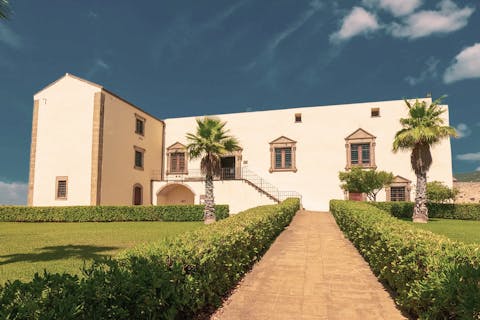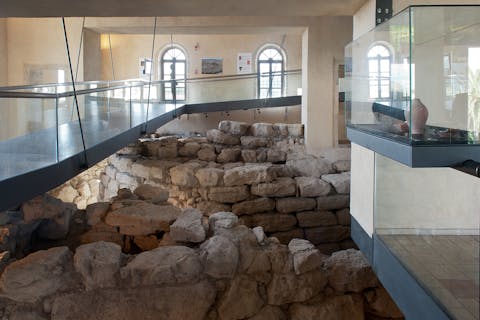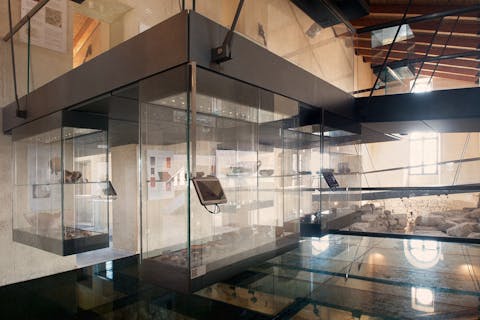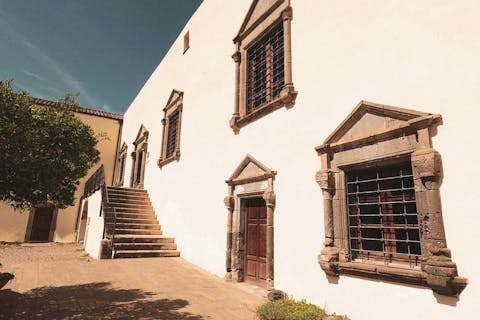Casa Zapata in Barumini, Visiting Information I Olianas

Art and culture
Casa Zapata: a journey through time in the Museum Pole
There’s an amazing site to visit at just 8 kilometers (less than 5 miles) from Tenuta Olianas. Its name is Casa Zapata, and it is the result of a unique historical combination. Walking on its suspended platforms and transparent floors allows visitors to admire the distinctive layering that chronicles Barumini's history in all its glory.
Imagine entering a 17th-century villa and then being catapulted back thousands of years, into the depths of the Nuragic culture…. that’s what one experiences at Casa Zapata! Visitors are taken on a journey that allows them to discover the most ancient and mysterious civilization that ever ruled over Sardinia. The villa also houses singular, fascinating features that provide inspiring insight into the noble Aragonese family who once owned it, the Zapatas, and the period of Spanish domination in Sardinia.
Ready? Let us lead you on a voyage among the secrets and beauty of Sardinia!
Our island has forever been multicultural, a true crossroads of different traditions and diverse populations. Sardinia’s history was shaped and forged by its many dominations, each of which left deep marks, and cultural and scenic influences that have made the island’s rugged inland so evocative and rich in character. It’s a heavenly place, a worthy counterpart of the uniquely fascinating coastal environment.
Closely linked to the Kingdom of Sardinia, the Zapatas were among the first Aragonese families to settle on the island. They ruled over the area between Marmilla and Sarcidano for nearly half a millennium. Casa Zapata, an imposing villa built to showcase the family’s power and its allegiance to the Spanish kingdom, well embodies the feud’s power and influence.

The Zapata estate in Barumini harbored a secret that the Spanish nobility never unveiled. Only many years after the end of the Zapata dynasty did the municipality of Barumini decide to turn the former noble mansion into a museum, and use its vast halls to exhibit the precious artifacts found at Su Nuraxi, to this day the only UNESCO-listed nuraghe.
The mansion, grand and imposing, was deemed the perfect setting, and one that would allow visitors to immerse themselves in the centuries-old Nuragic culture. As things turned out, this idea was more than correct, because when restoration work on the palace started, an incredible fact came to light: Casa Zapata had actually been built on top of a nuraghe!
The renovation of the Zapata palace proved to be an exciting experience from the very beginning. In 1990, the builders discovered the walls of a large underground structure lying beneath the load-bearing walls of Casa Zapata: the mansion had been built by encompassing a huge three-lobed nuraghe! This unforeseen and unprecedented circumstance enriched Barumini's heritage by adding the 31st Nuragic site - Su Nuraxi 'e Cresia - to its already impressive legacy.
Hence, the former historic dwelling became the Casa Zapata Museum Complex, a unique combination of Aragonese-Sardinian architecture and the centuries-old Nuragic civilization. A civilization that was, from then on, to be represented both by the artifacts found at Su Nuraxi and by the “brand-new” nuraghe. Suspended walkways and glass floors were built to allow visitors to fully appreciate the site’s impressive features and enjoy fascinating views of the Nuragic building from above.

The Casa Zapata museum complex comprises three different bodies: an archeological area, a historical one, and an ethnographic one. The latter two provide visitors with the opportunity to explore the history of the Zapata family and the Nuragic craft tradition. The former, on the other hand, offers a bird's-eye view of the nuraghe and comprises a display of the artifacts found in Barumini's nuraghi.
The Casa Zapata Museum Complex is open year-round 7 days a week, starting from 9:00 am.
Closing hours vary according to the season (and duration of daylight), as specified below:
- at 8:00 pm in May, June, July, and August
- at 5:00 pm in November, December, January, and February
- at 7:30 pm in April and September
- at 6:30 pm in October
- at 5:30 pm in March
Tours are led by in-house guides and scheduled at regular intervals: tour departures are generally every half hour.
Entrance fees:
- Adults: €15 per person
- Young adults (13 to 17): €12 per person
- Children (7 to 12 years old): €9 per person
- Babies and children up to 6 years old: free of charge
The above-listed entrance fees include access and guided tours (approximately 1 hour per each site) of:
1) Su Nuraxi - Sardinia’s most impressive archeological site, and the only nuraghe to be included in the UNESCO World Heritage Site listing.
--> Find out more about Su Nuraxi
2) The Centro Giovanni Lilliu - named after Giovanni Lilliu, the archeologist who conducted the excavation campaign at the Su Nuraxi site.
Please visit the Fondazione Barumini Sistema Cultura website for further information regarding group tours, reservations, and tour logistics in case of bad weather.

There is so much more to Sardinia than just the sea, particularly in the Barumini area.
In addition to the Su Nuraxi site and Centro Giovanni Liliu, our island is home to wonderful natural parks, which are bound to amaze you with their beauty, pristine wild nature, and unique secrets.
The images on the page are courtesy of Daniela Podda.
